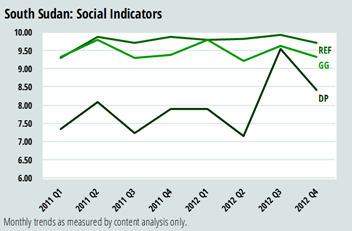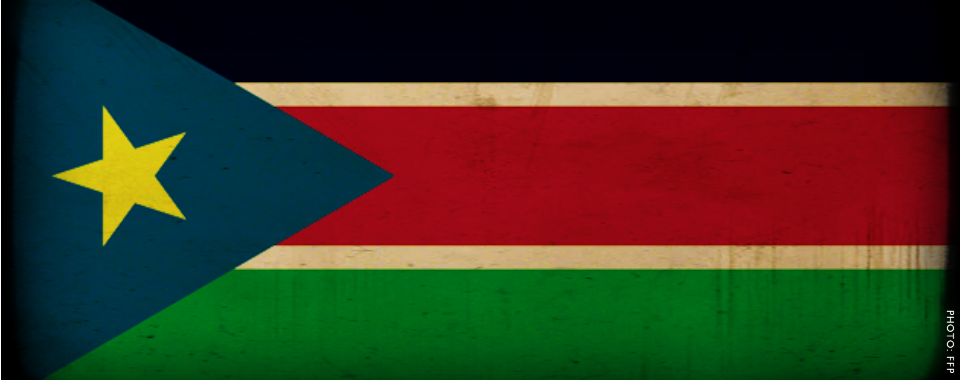BY NATE HAKEN AND PATRICIA TAFT
For sustainable human security, statebuilding is the only endgame. Absent the state, traditional mechanisms and authority structures might indeed manage communal issues, perhaps even better than would the state. Trans-communal issues like environmental degradation, complex humanitarian emergencies, and large scale conflict, however, go beyond the jurisdiction and capacity of such entities. Building a legitimate, professional, and representative state, therefore, is the only way to address the problems of the modern, interconnected world. This process is inherently messy, however, as demonstrated in the case of the world’s newest state, South Sudan, number four on this year’s Failed States Index.
We must be clear-eyed about what statebuilding means. New states bring with them many things, and foremost is often unrealistic expectations. A state is not an exogenous entity dropped in from above to solve the problems down below. A polarized society gives rise to a polarized state. Institutions can be co-opted and power abused, especially in the early years as militias are subsumed into the public security forces and warlords are appointed or elected into positions of national leadership.
When South Sudan finally gained independence in July of 2011, it had come at a huge cost. Between 1983 and 2005, over two million people died in a war that for decades seemed to have no end. A popular narrative of the war spread in capitals around the world describing the conflict as one of a Christian South suppressed and plundered by a Muslim North. This narrative represents a portion of the truth. A small group of Northerners did control, marginalize and wage war against a group of mainly Southerners. But it did not reflect the full reality of the conflict and history of the country.
In addition to the hundreds of thousands of displaced persons, destroyed property and infrastructure, and near total economic devastation in the South, there were deeply ingrained cleavages throughout society exacerbated by years of fighting. Along with the well-defined fault lines between rival armies and militias and the political leadership of the “two Sudans,” groups divided further along tribal and religious lines as well as over issues such as land, political control and the economic opportunities created by the conflict. Nevertheless the “North bad/South good” perception helped spur action to end the conflict and push for implementation of the Comprehensive Peace Agreement in January 2005 which resulted in the Republic of South Sudan.
 Following the heady days of independence, ceremonies and gestures of goodwill buffered the new country for some time. Development projects and money flooded into the country to repair the damage of decades of war. Focus shifted to supporting the new government, nominally made up of the “good guys,” to expand their reach and create a sustainable state, from building police posts to large scale agricultural schemes. However, not even six months after the country was born, violence flared again internally, most notably in Jonglei state where ethnic groups pitted against each other in a conflict that has its roots in history but was raised to a new level with the easy availability of small arms and the heightened stakes of independence. A disarmament campaign, launched by the government and logistically supported by the United Nations Mission in South Sudan (UNMISS), aimed to curb the violence but only exacerbated tensions as it initially targeted a minority group, the Murle, and reports of abuses by the security forces during the exercise abounded. Nearly a year and a half after the campaign was launched, the conflict and its effects continue. In November 2012, a Médecins Sans Frontières (MSF) report accused the government of hindering relief efforts for internally displaced people in the state by refusing to grant permission for their staff to travel to those areas. Statements and reports over the disarmament abuses, continued fighting between the South Sudanese military (SPLA) and rebel groups, threats to civilians, and challenges to providing emergency aid have trickled out mainly from civil society and NGOs but there has been a surprising lack of noise from international governments and the UN about the ongoing violence.
Following the heady days of independence, ceremonies and gestures of goodwill buffered the new country for some time. Development projects and money flooded into the country to repair the damage of decades of war. Focus shifted to supporting the new government, nominally made up of the “good guys,” to expand their reach and create a sustainable state, from building police posts to large scale agricultural schemes. However, not even six months after the country was born, violence flared again internally, most notably in Jonglei state where ethnic groups pitted against each other in a conflict that has its roots in history but was raised to a new level with the easy availability of small arms and the heightened stakes of independence. A disarmament campaign, launched by the government and logistically supported by the United Nations Mission in South Sudan (UNMISS), aimed to curb the violence but only exacerbated tensions as it initially targeted a minority group, the Murle, and reports of abuses by the security forces during the exercise abounded. Nearly a year and a half after the campaign was launched, the conflict and its effects continue. In November 2012, a Médecins Sans Frontières (MSF) report accused the government of hindering relief efforts for internally displaced people in the state by refusing to grant permission for their staff to travel to those areas. Statements and reports over the disarmament abuses, continued fighting between the South Sudanese military (SPLA) and rebel groups, threats to civilians, and challenges to providing emergency aid have trickled out mainly from civil society and NGOs but there has been a surprising lack of noise from international governments and the UN about the ongoing violence.
At best, the government can do little to stop the violence and accompanying humanitarian crises. At worst, whispers echo that the violence in Jonglei and elsewhere like Warrap and Upper Nile is being spurred on by politicians and power brokers who are interested in land, money, and revenge. The government most often points the blame at Khartoum, which was in fact found complicit in providing assistance to South Sudanese rebels. There was never much consideration given, however, to the idea that there are also legitimate grievances and deep internal divisions underlying the conflict that have nothing to do with Khartoum. The usual answer to outbreaks of conflict in South Sudan has been heavy SPLA crackdowns sometimes accompanied by one-off peace conferences that leave behind a trail of unfulfilled recommendations for development, infrastructure, political representation, and security.
 Compounding the outbreak of fighting and humanitarian emergencies that gripped the country throughout 2012, the new government in Juba struggled to reconcile its former rebel roots with its newfound responsibilities to lead a democratic and developing country. Media freedom was increasingly curtailed in 2012. The killing of a well-known commentator and journalist in December, the arbitrary arrest, beatings, and detention of members of the press, and the failure of the government to enact media laws were all strongly condemned internationally, leading the country to rank 124 of 180 on the 2013 World Press Freedom Index by Reporters without Borders. The South Sudan National Security Services, a security apparatus whose functions and mandate have never been clearly defined by law, was repeatedly cited as carrying out attacks on journalists, including harassment and illegal detention. This fueled speculation that the new government routinely engages such praetorian forces to deal with dissent rather than go through official state-sanctioned channels, perhaps a hangover from its early days as a guerrilla movement. In addition, international organizations have begun to confront a familiar problem as some international aid workers are forced, for seemingly political reasons, to leave the country with little public resistance or outcry from their agencies or other international observers.
Compounding the outbreak of fighting and humanitarian emergencies that gripped the country throughout 2012, the new government in Juba struggled to reconcile its former rebel roots with its newfound responsibilities to lead a democratic and developing country. Media freedom was increasingly curtailed in 2012. The killing of a well-known commentator and journalist in December, the arbitrary arrest, beatings, and detention of members of the press, and the failure of the government to enact media laws were all strongly condemned internationally, leading the country to rank 124 of 180 on the 2013 World Press Freedom Index by Reporters without Borders. The South Sudan National Security Services, a security apparatus whose functions and mandate have never been clearly defined by law, was repeatedly cited as carrying out attacks on journalists, including harassment and illegal detention. This fueled speculation that the new government routinely engages such praetorian forces to deal with dissent rather than go through official state-sanctioned channels, perhaps a hangover from its early days as a guerrilla movement. In addition, international organizations have begun to confront a familiar problem as some international aid workers are forced, for seemingly political reasons, to leave the country with little public resistance or outcry from their agencies or other international observers.
South Sudan may have lots of window dressing but as of yet none of the actual underpinnings of viable statehood. While shiny 4×4 vehicles, hotels, new banks and stores are popping up in the capital of Juba, outside there is the near complete absence of development or infrastructure. The new government, reliant for 90% of its revenue from oil, was nearly bankrupt by the end of the year because months of disputes with Khartoum had led Juba to turn off the pump in January of 2012. A mid-year attempt by the government to begin collecting taxes was also met with widespread reluctance amid reports that government officials had “misplaced” and “stolen” nearly USD 4 billion. Officials urged citizens not to worry as international donors would fill the budget shortfalls further fueling speculation that not only did the new government lack the necessary skills to run a state absent international assistance, it also had little incentive to try. The US government obliged with an international conference in April 2013 aimed at increasing investment and development funding for the fledgling state. Only time will tell if this actually translates into something meaningful.
Throughout 2012, the “good” guys of South Sudan were suddenly not looking so great. This should not be surprising. Experiences from southeastern Europe in the late nineties and early 2000s and our experiments in statebuilding in Afghanistan and Iraq have repeatedly shown that imposing a state structure, democratic or otherwise, on top of a country or territory that has been in a constant state of warfare for decades is bound to be chaotic. For those who cared to look behind the narrative, the signs that all was not well in South Sudan were there years before the referendum on independence. We must again acknowledge that statebuilding is not a technical exercise but an inherently political process that brings inevitable tensions between the extension and empowerment of state authority and accountability and the upholding of human rights. In the case of South Sudan, the recognition that this tension exists and tradeoffs have been made by those in power seems to have come belatedly or simply remains behind closed doors. The first step is not to ignore or paper over these problems in the name of “keeping it together” but to deal with them honestly and fully in order to avoid compounding existing grievances and divisions that will continue the cycle of violence and marginalization.
South Sudan has a long road ahead of it to create a democratic and prosperous nation, and it will undoubtedly take time and the efforts of many. Nobody understands this better than the average South Sudanese who deal everyday with the contradictions of living in a state born to be free and peaceful but who are currently insecure and restricted. Those who have pledged to help these citizens achieve what South Sudan was meant to be should confront the realities they experience and not the narratives or politics others create.
